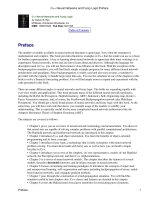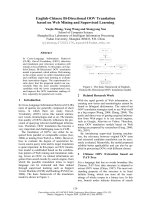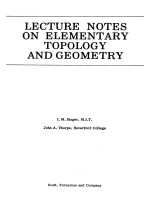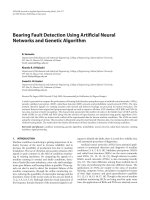Notes on neural networks and deep learning
Bạn đang xem bản rút gọn của tài liệu. Xem và tải ngay bản đầy đủ của tài liệu tại đây (17.63 MB, 268 trang )
Introduction to Neural Networks and Deep Learning
Introduction to the Convolutional Network
Andres Mendez-Vazquez
March 28, 2021
1 / 148
Outline
1
Introduction
The Long Path
The Problem of Image Processing
Multilayer Neural Network Classification
Drawbacks
Possible Solution
2
Convolutional Networks
History
Local Connectivity
Sharing Parameters
3
Layers
Convolutional Layer
Convolutional Architectures
A Little Bit of Notation
Deconvolution Layer
Alternating Minimization
Non-Linearity Layer
Fixing the Problem, ReLu function
Back to the Non-Linearity Layer
Rectification Layer
Local Contrast Normalization Layer
Sub-sampling and Pooling
Strides
Normalization Layer AKA Batch Normalization
Finally, The Fully Connected Layer
4
An Example of CNN
The Proposed Architecture
Backpropagation
Deriving wr,s,k
Deriving the Kernel Filters
2 / 148
Outline
1
Introduction
The Long Path
The Problem of Image Processing
Multilayer Neural Network Classification
Drawbacks
Possible Solution
2
Convolutional Networks
History
Local Connectivity
Sharing Parameters
3
Layers
Convolutional Layer
Convolutional Architectures
A Little Bit of Notation
Deconvolution Layer
Alternating Minimization
Non-Linearity Layer
Fixing the Problem, ReLu function
Back to the Non-Linearity Layer
Rectification Layer
Local Contrast Normalization Layer
Sub-sampling and Pooling
Strides
Normalization Layer AKA Batch Normalization
Finally, The Fully Connected Layer
4
An Example of CNN
The Proposed Architecture
Backpropagation
Deriving wr,s,k
Deriving the Kernel Filters
3 / 148
The Long Path [1]
2018
Channel
Boosting
Beyond
2018
Attention
Channel Boosted CNN
CBAM
Residual Attention
Module
2018
Feature Map
Explotation
A Small History
of a
Revolution
Complex Architectures and
The Attention Revolution
PolyNet
WideResNext
2017
ResNext
The Beginnig of Atention?
ZfNet
Parameter
Optimization
Residual and Multipath
Architectures
2016
Multi-Path
Connectivity
FractalNet
Dense Net
ResNet
2015
Skip Connections
Highway Net
Depth
Revolution
VGG
2014
Effective Reception Filed
(Small Size Filters)
Inception-ResNet
Factorization
Spatial
Explotation
Depth
Explotation
Spatial
Explotation
2010 ImageNet
2006 GPU
2007 NVIDIA
PROGRAMMING
The Revolution
Inception-V2
Parallelism
2014
GoogleNet
Inception
Block
First Results
Inception-V4
Inception-V3
Bottleneck
2006 Maxpooling
6.5
Early 2000
CNN Stagnation
5
9
Feature
Visualization
2017
4.5
SE Net
Transformers-CNN
PyramidalNet
Width
Explotation
4 5 1 1
2 6 2 6
3 5 7 3
1 9 2 1
CMPE-SE
2013
2012
3D CNN's
AlexNet
1998
LeNet
1989
Early Attempts
1979
ConvNet
Neurocognition
4 / 148
Outline
1
Introduction
The Long Path
The Problem of Image Processing
Multilayer Neural Network Classification
Drawbacks
Possible Solution
2
Convolutional Networks
History
Local Connectivity
Sharing Parameters
3
Layers
Convolutional Layer
Convolutional Architectures
A Little Bit of Notation
Deconvolution Layer
Alternating Minimization
Non-Linearity Layer
Fixing the Problem, ReLu function
Back to the Non-Linearity Layer
Rectification Layer
Local Contrast Normalization Layer
Sub-sampling and Pooling
Strides
Normalization Layer AKA Batch Normalization
Finally, The Fully Connected Layer
4
An Example of CNN
The Proposed Architecture
Backpropagation
Deriving wr,s,k
Deriving the Kernel Filters
5 / 148
Digital Images as pixels in a digitized matrix [2]
Ilumination
Source
Output
Ilumination
Source
6 / 148
Further [2]
Pixel values typically represent
Gray levels, colors, heights, opacities etc
Something Notable
Remember digitization implies that a digital image is an
approximation of a real scene
7 / 148
Further [2]
Pixel values typically represent
Gray levels, colors, heights, opacities etc
Something Notable
Remember digitization implies that a digital image is an
approximation of a real scene
7 / 148
Images
Common image formats include
On sample/pixel per point (B&W or Grayscale)
Three samples/pixel per point (Red, Green, and Blue)
Four samples/pixel per point (Red, Green, Blue, and “Alpha”)
8 / 148
Therefore, we have the following process
Low Level Process
Imagen
Noise
Removal
Sharpening
9 / 148
Example
Edge Detection
10 / 148
Then
Mid Level Process
Input
Processes
Output
Object
Image Recognition Attributes
Segmentation
11 / 148
Example
Object Recognition
12 / 148
Therefore
It would be nice to automatize all these processes
We would solve a lot of headaches when setting up such process
Why not to use the data sets
By using a Neural Networks that replicates the process.
13 / 148
Therefore
It would be nice to automatize all these processes
We would solve a lot of headaches when setting up such process
Why not to use the data sets
By using a Neural Networks that replicates the process.
13 / 148
Outline
1
Introduction
The Long Path
The Problem of Image Processing
Multilayer Neural Network Classification
Drawbacks
Possible Solution
2
Convolutional Networks
History
Local Connectivity
Sharing Parameters
3
Layers
Convolutional Layer
Convolutional Architectures
A Little Bit of Notation
Deconvolution Layer
Alternating Minimization
Non-Linearity Layer
Fixing the Problem, ReLu function
Back to the Non-Linearity Layer
Rectification Layer
Local Contrast Normalization Layer
Sub-sampling and Pooling
Strides
Normalization Layer AKA Batch Normalization
Finally, The Fully Connected Layer
4
An Example of CNN
The Proposed Architecture
Backpropagation
Deriving wr,s,k
Deriving the Kernel Filters
14 / 148
Multilayer Neural Network Classification
We have the following classification [3]
15 / 148
Outline
1
Introduction
The Long Path
The Problem of Image Processing
Multilayer Neural Network Classification
Drawbacks
Possible Solution
2
Convolutional Networks
History
Local Connectivity
Sharing Parameters
3
Layers
Convolutional Layer
Convolutional Architectures
A Little Bit of Notation
Deconvolution Layer
Alternating Minimization
Non-Linearity Layer
Fixing the Problem, ReLu function
Back to the Non-Linearity Layer
Rectification Layer
Local Contrast Normalization Layer
Sub-sampling and Pooling
Strides
Normalization Layer AKA Batch Normalization
Finally, The Fully Connected Layer
4
An Example of CNN
The Proposed Architecture
Backpropagation
Deriving wr,s,k
Deriving the Kernel Filters
16 / 148
Drawbacks of previous neural networks
The number of trainable parameters becomes extremely large
Large N
A
Z
17 / 148
Drawbacks of previous neural networks
In addition, little or no invariance to shifting, scaling, and other forms
of distortion
Large N
A
Z
18 / 148
Drawbacks of previous neural networks
In addition, little or no invariance to shifting, scaling, and other forms
of distortion
Large N
Shift to the Left
A
Z
19 / 148
Drawbacks of previous neural networks
The topology of the input data is completely ignored
20 / 148
For Example
We have
Black and white patterns: 232×32 = 21024
Gray scale patterns: 25632×32 = 2561024
21 / 148
For Example
If we have an element that the network has never seen
22 / 148
Possible Solution
We can minimize this drawbacks by getting
Fully connected network of sufficient size can produce outputs that
are invariant with respect to such variations.
Problem!!!
Training time
Network size
Free parameters
23 / 148




![Lecture notes on c algebras and quantum mechanics [jnl article] n lamdsman](https://media.store123doc.com/images/document/14/rc/rt/medium_6PjfnHupCQ.jpg)




